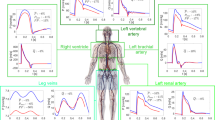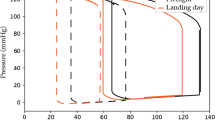Abstract
A numerical model of the cardiovascular system was used to quantify the influences on cardiac function of intrathoracic pressure and intravascular and intraventricular hydrostatic pressure, which are fundamental biomechanical stimuli for orthostatic response. The model included a detailed arterial circulation with lumped parameter models of the atria, ventricles, pulmonary circulation, and venous circulation. The venous circulation was divided into cranial, central, and caudal regions with nonlinear compliance. Changes in intrathoracic pressure and the effects of hydrostatic pressure were simulated in supine, launch, sitting, and standing postures for 0, 1, and 1.8 G. Increasing intrathoracic pressure experienced with increasing gravity caused 12% and 14% decreases in cardiac output for 1 and 1.8 G supine, respectively, compared to 0 G. Similar results were obtained for launch posture, in which the effects of changing intrathoracic pressure dominated those of hydrostatic pressure. Compared to 0 G, cardiac output decreased 0.9% for 1 G launch and 15% for 1.8 G launch. In sitting and standing, the position of the heart above the hydrostatic indifference level caused the effects of changing hydrostatic pressure to dominate those of intrathoracic pressure. Compared to 0 G, cardiac output decreased 13% for 1 G sitting and 23% for 1.8 G sitting, and decreased 17% for 1 G standing and 31% for 1.8 G standing. For a posture change from supine to standing in 1 G, cardiac output decreased, consistent with the trend necessary to explain orthostatic intolerance in some astronauts during postflight stand tests. Simulated lower body negative pressure (LBNP) in 0 G reduced cardiac output and mean aortic pressure similar to 1 G standing, suggesting that LBNP provides at least some cardiovascular stimuli that may be useful in preventing postflight orthostatic intolerance. A unifying concept, consistent with the Frank–Starling mechanism of the heart, was that cardiac output was proportional to cardiac diastolic transmural pressure for all postures and gravitational accelerations. © 2002 Biomedical Engineering Society.
PAC2002: 8765+y, 8719Bb, 8719Uv, 8719Hh
Similar content being viewed by others
REFERENCES
Avolio, A. Multibranched model of the human arterial system. Med. Biol. Eng. Comput. 18:709–718, 1980.
Avula, X., and H. Oestreicher. Mathematical model of the cardiovascular system under acceleration stress. Aviat., Space Environ. Med. 49:279–286, 1978.
Blomqvist, C., and H. Stone. Cardiovascular adjustments to gravitational stress. In: Handbook of Physiology, edited by E. A. Shepherd. Washington, DC: American Physiology Society, 1982, pp. 1025–1063.
Buckey, J., F. Gaffney, L. Lane, B. Levine, D. Watenpaugh, S. Wright, C. Yancy, D. Meyer, and C. Blomqvist. Central venous pressure in space. J. Appl. Physiol. 81:19–25, 1996.
Buckey, J., L. Lane, B. Levine, D. Watenpaugh, S. Wright, W. Moore, F. Gaffney, and C. Blomqvist. Orthostatic intolerance after spaceflight. J. Appl. Physiol. 81:7–18, 1996.
Charles, J., M. Bungo, and G. Fortner. Cardiopulmonary function. In: Space Physiology and Medicine (3rd ed.), edited by A. E. Nicogossian et al. Philadelphia: Lea &; Febiger, 1994, pp. 286–304.
Convertino, V. Clinical aspects of the control of plasma volume at microgravity and during return to one gravity. Med. Sci. Sports Exercise 28:S45–S52, 1996.
Croston, R., and D. Fitzjerrell. Cardiovascular model for the simulation of exercise, lower body negative pressure, and tilt experiments. Modeling Simulation 5:471–476, 1974.
Davis, T. Teaching Physiology Through Interactive Simulation of Hemodynamics. Cambridge: MIT, 1991.
Gauer, O., and H. Thron. Postural change in the circulation. In: Handbook of Physiology, edited by W. Hamilton and P. Dow. Washington, DC: American Physiological Society, 1965, Sect. 2, p. 2409.
Gazenko, O., A. Grigoryev, S. Bugrov, V. Yegorov, V. Bogomolov, I. Kozlovskaya, and I. Tarasov. Review of the major results of medical research during the flight of the second prime crew of the Mir Space Station. Kosm. Biol. Aviakosm. Med. 23:3–11, 1990.
Gillingham, K., J. Freeman, and McNee. Transfer functions for eye level blood pressure during +Gz stress. Aviat., Space Environ. Med. 48:1026–1034, 1977.
Green, J. Fundamental Cardiovascular and Pulmonary Physiology: An Integrated Approach to Medicine. Philadelphia: Lea &; Febiger, 1982.
Green, J., and N. Miller. A model describing the response of the circulatory system to acceleration stress. Ann. Biomed. Eng. 1:455–467, 1973.
Guyton, A., T. Coleman, and H. Granger. Circulation: Overall regulation. Ann. Rev. Phys. 34:13–46, 1972.
Jaron, D., T. Moore, and J. Bai. Cardiovascular responses to acceleration stress: A computer simulation. Proc. IEEE76:700–707, 1988.
Jaron, D., T. Moore, and C.–L. Chu. A cardiovascular model for studying impairment of cerebral function during +Gz stress. Aviat., Space Environ. Med. 55:24–31, 1984.
Johnson, R., G. Hoffler, A. Nicogossian, S. Bergman, and M. Jackson. Lower body negative pressure: Third manned Skylab mission. In: Biomedical Results from Skylab, edited by R. Johnston and L. Dietlein. Washington, DC: NASA, 1977, Chap. 29, pp. 284–312.
Kinoshita, M., G. Burns, G. Pantalos, Chiang, and D. Olsen. Atrial compliance changes in animal total artificial heart recipients. ASAIO Trans. 37:M247–M248, 1991.
Mead, J., and E. Gaensler. Esophageal and pleural pressures in man, upright and supine. J. Appl. Physiol. 14:81–83, 1959.
Melchior, F., R. Srinivasan, and J. Charles. Mathematical modeling of human cardiovascular system for simulation of orthostatic response. Am. J. Physiol. 262:H1920–H1933, 1992 (Heart Circ. Physiol. 31).
Melchior, F., R. Srinivasan, P. Thullier, and J.–M. Clere. Simulation of cardiovascular response to lower body negative pressure from 0 to–40 mm Hg. J. Appl. Physiol. 77:630–640, 1994.
Niederer, P. Dam** mechanisms and shock transitions in the human arterial tree. J. Appl. Math. Phys. 36:204–220, 1985.
Ozawa, E., K. Bottom, X. **ao, and R. Kamm. Numerical simulation of enhanced external counterpulsation. Ann. Biomed. Eng. 29:284–297, 2001.
Pantalos, G., S. Hart, J. Mathias, M. Sharp, D. Watenpaugh, J. Buckey, S. Parnis, A. Hargens, and W. Thornton. Central venous, esophageal, and abdominal pressure in humans during parabolic flight. Am. Soc. Grav. &; Space Biol. Bull. 12:81, 1998.
Pantalos, G., M. Sharp, S. Woodruff, D. O'Leary, and K. Gillars. Simulation of cardiovascular adaptation to weightlessness. Am. Soc. Grav. &; Space Biol. Bull. 9:32, 1995.
Pedley, T., R. Schroter, and M. Sudlow. Energy losses and pressure drop in models of human airways. Respir. Physiol. 9:371–386, 1970.
Prisk, G., H. Guy, A. Elliot, R. Deutschman, and J. West. Pulmonary diffusing capacity, capillary blood volume, and cardiac output during sustained microgravity. J. Appl. Physiol. 75:15–26, 1993.
Rideout, V. Pressure–flow modeling of the cardiovascular system. In: Mathematical and Computer Modeling of Physiological Systems. Englewood Cliffs, NJ: Prentice–Hall, 1991, pp. 68–130.
Smith, J., and J. Kampine. Circulatory Physiology: The Essentials. Baltimore, MD: Williams and Wilkins, 1980.
Snyder, M., and V. Rideout. Computer simulation studies of the venous circulation. IEEE Trans. Biomed. Eng. 16:325–334, 1969.
Stettler, J., P. Niederer, and M. Anliker. Theoretical analysis of arterial hemodynamics including the influence of bifurcations. Part I: Mathematical model and prediction of normal pulse patterns. Ann. Biomed. Eng. 9:145–164, 1981.
Suga, H., and K. Sugawa. Instantaneous pressure—volume relationships and their ratio in the excised, supported canine left ventricle. Circ. Res. 35:117–126, 1974.
Suga, H., K. Sugawa, and L. Demer. Determinants of instantaneous pressure in canine left ventricle: Time and volume specification. Circ. Res. 46:256–263, 1980.
Thornton, W., T. Moore, and S. Pool. Fluid shifts in weightlessness. Aviat., Space Environ. Med. 58:A86–A90, 1987.
Videbaek, R., and P. Norsk. A trial distension in humans during weightlessness induced by parabolic flights. J. Appl. Physiol. 83:1862–1866, 1997.
Watenpaugh, D. Upper body venous compliance exceeds lower body venous compliance in humans. NASA Technical Memorandum 110409, pp. 1–28.
Watenpaugh, D. J. Buckey, L. Lane, F. Gaffney, W. Moore, B. Levine, S. Wright, and C. Blomqvist. Human leg blood flow and compliance during spaceflight. ASGSB Bull. 6:35, 1992.
Watenpaugh, D., and A. Hargens. The cardiovascular system in microgravity. In: Handbook of Physiology—Environmental Physiology, 1995, Chap. 29.
Westerhof, N., F. Bosman, C. DeVries, and A. Noordergraaf. Analog studies of the human systemic arterial tree. J. Biomech. 2:121–43, 1969.
White, R., and C. Blomqvist. Central venous pressure and cardiac function during spaceflight. J. Appl. Physiol. 85:738–746, 1998.
Zeilke, W. Frequency–dependent friction in transient pipe flow. J. Basic Eng. 90:109, 1968.
Author information
Authors and Affiliations
Rights and permissions
About this article
Cite this article
Peterson, K., Ozawa, E.T., Pantalos, G.M. et al. Numerical Simulation of the Influence of Gravity and Posture on Cardiac Performance. Annals of Biomedical Engineering 30, 247–259 (2002). https://doi.org/10.1114/1.1451075
Issue Date:
DOI: https://doi.org/10.1114/1.1451075




